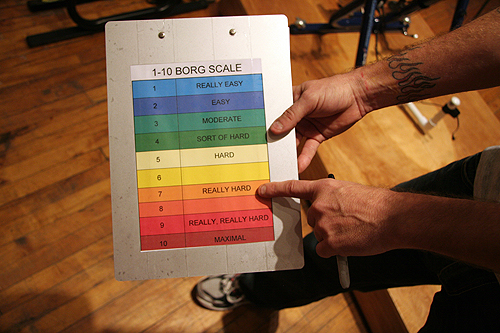Last October, I met with Foss and St-Jacques for a fitness evaluation, including a blood test that assessed my tolerance during high-output athletics. Standing beside a treadmill, Foss pulled on a rubber glove and grabbed a needle. “Let’s hit 170,” he said, referencing a heart-rate target.
I ran and sweated, my heart and lungs ascending the aerobic ladder. Foss pointed at a chart with 10 categories of “perceived exertion.” He motioned toward No. 9 on the scale, marked “Really, Really Hard.” “You about here?” he asked.

Then Foss pricked my finger with a needle, feeding a blood drop to a handheld meter. He later calculated my lactate-threshold level to formulate a heart-rate-based fitness plan.
My next session at Fix, a couple weeks later, included a bike fitting. But St-Jacques had me face down on a massage table before I put my bike shoes on. “We need to evaluate your body,” she said.
St-Jacques, who has a college degree in athletic therapy, combines personal athletics experience with book knowledge. Her hands worked down my spine, fingers digging in. She noted a tightness in my left hip and used a therapeutic technique to alleviate the stress.

On a bike trainer, Foss adjusted a laser level and aimed a video camera. He recorded my pedal strokes for playback on a screen, stopped frames distilling motions in frozen time. “Look at that left knee dip,” Foss said, a pen touching the monitor’s glass.
A consultation with Foss and St-Jacques focuses first on the body, second on the equipment at hand. On the bike, Foss said he could add a shim to my left shoe to correct the knee wobble. “But first we should try again to adjust that hip,” he said.
St-Jacques looked back at the massage table. She mentioned setting up a session for a “full musculoskeletal evaluation.” She said, “We need to get your body in line before you get back on the bike.”
—Stephen Regenold is founder and editor of www.gearjunkie.com.






